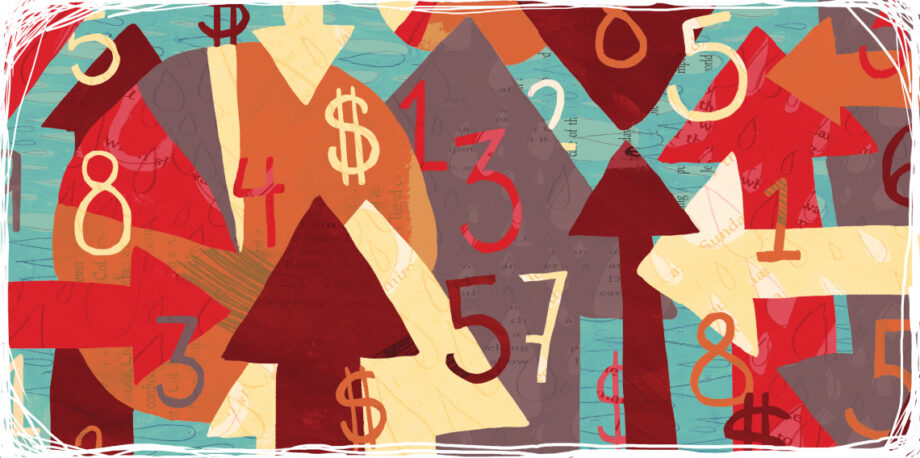September 17, 2013 — Corporate sustainability reports have been around since … well, it’s hard to say. The first report may have been published by “companies in the chemical industry with serious image problems” in the 1980s, or by Ben & Jerry’s in 1989 or Shell in 1997. No matter — since then, more than 10,000 companies have published more than 50,000 reports, according to CorporateRegister.com, which maintains a searchable database of reports.
But who really reads them? As a reporter who covers business and sustainability, I do. Maybe you do, too — as an employee, investor, researcher or activist.
Here, then, are five tips to help you make sense of the next report that lands on your desk or arrives via email. They were developed with help from Steve Lydenberg of Domini Social Investments — the principal author of How to Read a Corporate Social Responsibility Report [pdf], an excellent 2010 study from the Boston College Center for Corporate Citizenship — and Bill Baue, a consultant and leader of the Sustainability Context Group, an organization working to improve corporate reporting.
1. Pay attention to what’s in the report — and what’s left out. Lots of companies fill their sustainability reports with anecdotes, but these are often off point. Chevron’s 2012 corporate responsibility report [pdf] says a Chevron executive in Angola is part of “a team that protects endangered turtles that come ashore to breed, dig sandy nests and lay their eggs on the beaches at Chevron’s Malongo oil production facilities.” And we learn that the company has partnered with the Wildlife Conservation Society to “introduce passive acoustic monitoring in the south Atlantic Ocean to assess humpback whale breeding activity” as it explores for oil.
That’s nice, but environmentalists will want to understand what the giant oil company (2012 revenues: $234 billion) is doing about climate change, if anything. Figuring that out from the report is hard, if not impossible. Chevron reports that its 2012 emissions from operations were 56.3 million metric tons of CO2 equivalent, down by about 3.5 million metric tons from 2011, and below its goal of 60.5 million metric tons. That sounds like progress. But you have to read the footnotes to learn that the decline was largely caused by the sale of one refinery in Alaska and “decreased production” from a second refinery in Richmond, Calif., where an August 2012 fire sent thousands of people to hospitals and later led Chevron to pay $2 million in fines and restitution.
What’s more, emissions from operations account for only part of Chevron’s impact. The company’s report says, “combustion of our products resulted in emissions of approximately 364 million metric tons of CO2 in 2012, approximately 8 percent less than the 396 million metric tons emitted in 2011.” Why the decline? Is the fact that people are burning less gas and oil good for the planet but bad for Chevron? The report doesn’t explain.
A good sustainability report should focus on those company activities that have the greatest impact.More importantly, is Chevron trying to move away from fossil fuels and develop cleaner forms of energy? It doesn’t seem to be, since the word “renewable” appears nowhere in the body of the report.
2. Follow the (big) money. A good sustainability report should focus on those company activities that have the greatest impact. So, for example, what matters most in the financial services industry is not paper consumption, LEED-certified work spaces or direct greenhouse gas emissions, but lending and investment practices. Citi’s most recent report [pdf] says it opened 23 LEED-certified branches in 2012 — a data point that is hard to put into context (since the report doesn’t say how many branches the company operates) and not very meaningful, in any event. What we want to know about Wall Street is how the big banks are taking environmental issues into account in their lending and investments. “No other industry has as much ability to affect the environmental and social practices of other industries as financial services does,” says Lydenberg.
Bank of America tackles the big question better than most. In its report [pdf], BofA says it has committed $70 billion over 16 years to “address global climate change and demands on natural resources,” and it describes the goal as “the largest among our peers.” That’s helpful. The bank also tallies where the first $21 billion of its climate-friendly financing has gone. To its credit, BofA also tries to explain why it does business with the coal industry in the face of criticism from environmental groups. “If large financial institutions were to unilaterally discontinue financing the coal industry, it would have negative consequences for the U.S. and global economies,” the BofA report says. The bank also notes, helpfully, that it supports government policies to tax or regulate carbon emissions.
Like most banks, however, BofA doesn’t provide an accounting of its loans to or investments in fossil fuel companies. (According to the Rainforest Action Network, BofA finances Coal India, one of the world’s biggest coal mining companies, which has displaced forest communities and destroyed critical tiger habitat.) How do Bank of America’s investments in fossil fuels, which aggravate climate change, compare to the $70 billion it has pledged to finance, in part, climate solutions? Is the bank making the climate crisis better or worse? Good luck finding out.
You can be confident that most companies present their data in the most favorable light.
3. Think about context. When trying to understand a company’s impact on climate or energy usage or water, a single number or two won’t help. You’ll need to look at absolute numbers (how much energy did the company use, in total), normalized numbers (adjusting for acquisitions or divestitures), and numbers that reflect energy or water intensity (how much was used per unit of product or dollar of revenues). These numbers only become meaningful when they are accompanied by year-over-year comparisons, or when set against previous goals. You can be confident that most companies present their data in the most favorable light.
The concept of context-based sustainability is designed, in part, to cut through obfuscations and generate meaningful sustainability goals and targets. The idea is elegant: Companies should measure their impacts against science-based sustainability thresholds and resource limits. Is Coca-Cola only using its fair share of the water supply in India? What should Ford’s carbon reduction target be? These aren’t easy questions, but Baue and Mark McElroy of the Center for Sustainable Organizations — leading advocates of context-based sustainability — say answers can be found. Companies, for example, could for reporting purposes be allocated a share of greenhouse gas emissions based on their contributions to gross national product; they would then set emissions reduction targets that are deep enough to meet global climate goals, and report on their progress against those targets.
Several companies are experimenting with context-based sustainability, including the Vermont dairy company Cabot Creamery Cooperative, EMC and Mars. BT (British Telecom) has developed a methodology to determine its share of GHG emissions, as has the California software company Autodesk, which makes its tool, called C-FACT [pdf] (Corporate Finance Approach to Climate-Stabilizing Targets), available for free.
4. Read more than one report at a time. How many glasses of water does it take to brew a gallon of beer? I have no idea either, so reading that New Belgium, a Colorado brewing company, wants to reduce its water use per barrel to 3.5 to 1 by 2015 doesn’t tell me much. In 2011, the ratio was 4.22 to 1.
New Belgium has a well-deserved reputation for sustainability but when it comes to water, the brewer lags behind its bigger competitors. MillerCoors’ latest sustainability report [pdf] says it achieved an average water-to-beer ratio of 3.82 to 1 across its major breweries, while the world’s biggest beer company, Anheuser-Busch InBev, does even better, reporting a water-to-beer production ratio of 3.5 to 1.
Good sustainability reporting, above all, needs to be credible.Reading the Coca-Cola and PepsiCo reports side by side is more enlightening than reading one at a time. The same with UPS and FedEx. But be aware that peer-to-peer comparisons are inexact. New Belgium explains that a practice called “dry hopping” has increased the water intensity in the brewing process. A bottle of Fat Tire is not the same as a Bud or a Coors Light, as any beer drinker knows.
5. Look for all the news that’s fit to print. Good sustainability reporting, above all, needs to be credible. It’s not easy to decide whether to trust what a company is telling us, but one sign is whether companies deliver the bad news along with the good. In the Chevron report, the refinery fire in Richmond, as well as a fire on an offshore oil-drilling rig near Nigeria, get only a passing mention. “These incidents do not reflect the expectations we have of ourselves,” the report says. We should hope not.
By contrast, Gap has been more willing than most companies to air its dirty linen (pun intended). The company has been forthcoming about what it calls “the severity of worker safety issues in Bangladesh” since 2010. When it comes to the environment, the company is clear about where it will exert its influence — over its supply chain and its own operations — and where it will leave the problems for others to solve.
At the end of the day, the most important thing to know about corporate sustainability reports may be that they almost inevitably raise more questions than they answer. A report cannot, by itself, be relied upon to explain a company’s environmental impact. It’s a useful starting point, at best.
![]()
Editor’s note: The views expressed here are those of the author and not necessarily of Ensia. We present them to further discussion around important topics. We encourage you to respond with a comment below, following our commenting guidelines, which can be found here. In addition, you might consider submitting a Voices piece of your own. See Ensia’s “Contact” page for submission guidelines.
Ensia shares solutions-focused stories free of charge through our online magazine and partner media. That means audiences around the world have ready access to stories that can — and do — help them shape a better future. If you value our work, please show your support today.
Yes, I'll support Ensia!

As always, useful insights.
However, let's not over correct and allow the desire for standarization and comparability of reports snuff out the innovation and creativity that sustainability is intended to spur.
David
Great insights on what to look at from those complex sophisticated sustainability reports.
Another aspect to consider is if the sustainability report follows certain reporting standards like GRI standard.
I stumbled upon a article that focuses on automotive companies and what reporting standard they follow. This might interest you.
http://blogs.economictimes.indiatimes.com/ResponsibleFuture/entry/strategic-approach-towards-automotive-csr-part-1
I also give points to reports that include external stakeholder voices and criticism; Ford, Gap Inc., and GE come to mind as companies that have done so in the past.
There is also some thinking on corporate human rights reporting that might be of interest, e.g. http://www.ihrb.org/commentary/guest/checking_in_on_corporate_human_rights_reporting.html